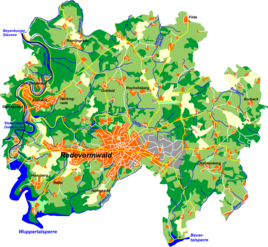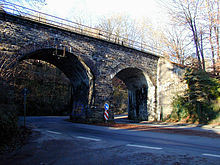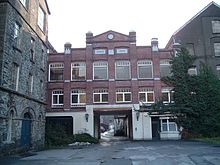Dahlhausen (Radevormwald)
|
Dahlhausen
City of Radevormwald
Coordinates: 51 ° 12 ′ 54 ″ N , 7 ° 18 ′ 37 ″ E
|
||
|---|---|---|
| Height : | 250 m above sea level NHN | |
| Incorporation : | 1929 | |
| Postal code : | 42477 | |
| Area code : | 02191 | |
|
Location of Dahlhausen in Radevormwald |
||
|
Former Hardt & Pocorny factory in Dahlhausen
|
||
Dahlhausen is a district of Radevormwald in the Oberbergischer Kreis in the North Rhine-Westphalian administrative district of Cologne in Germany . Dahlhausen is one of the so-called Wupper towns .
The neighboring towns are called Vogelsmühle , Dahlerau and Keilbeck . The formerly independent district Hardtbach , located on the western edge of the village, is now part of Dahlhausen.
history
The place was mentioned for the first time in 1317, namely “Dietmar von Dalhusen is a seal witness in a document for the Order of St. John at Burg ad Wupper”. The spelling of the first mention was Dalhusen . The Dahlhausen estate became the official knight's seat around 1600, when its owner obtained a seat and thus a right to vote in the Bergisches Landtag.
On July 1, 1872, the innkeeper G. Meyer was given a post office , which on January 10, 1874 was transferred to the post agent and innkeeper Robert Berghaus. On August 1, 1877, the postal agency became an independent post office and a private telegraph connection for the Wülfing company became the property of the German Empire.
On March 1, 1886, Dahlhausen gets a railway connection, because the opening of the railway line Lennep - Krebsöge - Dahlerau - Oberbarmen is celebrated .
In 1900 there is the first reference to the activity of a group of the German Red Cross in Dahlhausen in an edition of the Lenneper Kreisblatt.
In 1929 the town of Dahlhausen lost its independence when it was added to the town of Radevormwald as part of a regional reform.
Population development
In 1800 Dahlhausen had 12 inhabitants. In a population statistics published in 1836 for the Rhine department , Elberfeld district , Lennep canton , Lüttringhausen municipality for the year 1832, there are 10 residents in one house. At that time it was an arable farm. (Table in an article by Romerike Berge (Issue 1, 2005) on page 23) . In 1835 there were 154 inhabitants, 1854 281 inhabitants and 1875 650 inhabitants.
Attractions
Hardt & Pocorny

The village became famous for the Hardt & Pocorny textile factory , which is one of the three large factories on the Wupper, which are lined up like a string of pearls. Between 1815 and 1830, the industrialist Adolf Bauendahl from Radevormwald bought the grounds in the Vogelsmühle to run a cloth factory there. In 1855, however, the operation was shut down again and eleven years later the Johann Wülfing & Sohn company acquired the site in order to convert the factory into a carded yarn spinning mill. On January 1, 1884, the renamed carried Hardt, Pocorny & Co . In the heyday, the textile factory employed over 1,000 people. In 1974 the plant had to be closed for good, and since then large parts of the large area on the banks of the Wupper have been vacant. In 2004 a diploma thesis dealt with the area and developed possible usage concepts. A competition for architecture students was also announced, the aim of which was to come up with new ideas for sensible use of the site.
Museum train station Dahlhausen (Wupper)
In Dahlhausen there is also the Dahlhausen (Wupper) museum station of the Bergisch Märkische Eisenbahn. It is located on the railway line from Lennep to Oberbarmen , the Wuppertal Railway, built in 1886 . Since Lennep's textile manufacturers had built factories on the Wupper between Krebsöge and Beyenburg from the 1830s , the construction of the railway started from Lennep. The Förderverein Wupperschiene eV is currently restoring an approximately eight-kilometer-long, listed section of the route and is planning an excursion service with historic trains that will give the museum station a new use.
Historic flap
What in the picture looks like a neglected monument ready for scrap, is in reality the historical model of a dam of the Dahlhausen dam . This system is an example of the development history of the use of hydropower in the course of the industrial revolution. It was put into operation in 1921. Further details can be found on the adjacent information board from the Wupper Association, which has also been affected by vandalism.
The wolf and the fairy grape at Dahlhausen
A legend has grown up around the Wupperinsel Eiben .
A long, long time ago, even before the deep and impenetrable oak and beech forests in the valley of the Wupper were inhabited by people, lived a beautiful fairy between the present-day towns of Beyenburg and Krebsöge, who was always accompanied by a straw-gold wolf. One day it happened that a hunting party roamed the valley of the Wupper with the bracken pack on the hunt for the primal, the bison and the wild boar. The fiercest hunter, a fair-haired fellow of noble blood who rode ahead with the dogs, saw the fairy and the wolf. His heart aflame for the beautiful apparition and he took up the pursuit of the fleeing, floating beings. The Wupper was still a wild river that dug its own bed and often changed its course. The wild hunt ended where the Wupperinsel is located near the town of Dahlhausen today. The dogs had caught the wolf. The hunter took his bow and spear made of yew wood and killed the wolf. When he went to the wolf, he couldn't be found. The hunter laid down his bow at the place of shooting. He took his spear and went to where he saw the fairy escape. When he found neither the fairy nor the wolf, the hunter rammed his spear into the ground.
At the place where the wolf was killed, yew trees still grow today on the Wupperinsel, surrounded by yellow-blooming wild roses. Red wild roses surround the yew tree in the place where the fairy disappeared forever. The yew trees are popularly known as "Die Wolfseibe" and "Die Feeneibe". Neither the wolf nor the fairy were ever seen again. It is said that on dark nights, when the wind chases the clouds and ruffles the branches of the beeches and oaks, in the valley of the Wupper, one removes a wistful howl like that of a wolf. From the mountain heights, especially in spring and autumn, between night and dream, you can see the fairy veils pulling through the valley of the Wupper.
Culture and club life
- Youth Red Cross OV Dahlhausen
- DRK local group Dahlhausen
- Tuspo Dahlhausen 1883 ev
Hiking and biking trails
The following hiking trails lead through the village:
- The SGV main hiking route X7 ( Residenzenweg ) from Arnsberg to Düsseldorf-Gerresheim
- The district hiking trail ◇ 6 ( Wupperweg ) of the SGV district of Bergisches Land
- The road of work of the SGV district Bergisches Land
- The forest-water-wool-hiking trail
Daughters and sons of the city
- Johann Wilhelm Schmidt-Japing (1886–1960), theologian
- Julius Stursberg (1857–1909), German theologian
Individual evidence
- ↑ Topographical Information Management TIM-online, provided by the Cologne District Government
- ^ Historika25, Landesvermessungsamt NRW, sheet 4709, Barmen
- ^ Klaus Pampus: First documentary naming of Oberbergischer places (= contributions to Oberbergischen history. Sonderbd. 1). Oberbergische Department 1924 eV of the Bergisches Geschichtsverein, Gummersbach 1998, ISBN 3-88265-206-3 .
- ↑ Source: Dietmar Fennel
literature
- Norbert Wolff: The postal history of Dahlhausen and Dahlerau an der Wupper. Self-published, Bonn 1992.
- Manfred Heymann, Richard Hückesfeld jun .: Home. Self-published, Radevormwald 2002 (photo book with 106, partly previously unpublished, photos from Dahlhausen, Vogelsmühle, Dahlerau, Nieder- and Oberdahl, Keilbeck, Herkingrade, Altenhof and Remlingrade, 80 pages).








